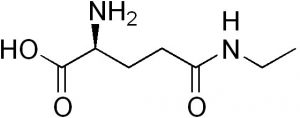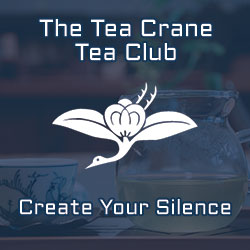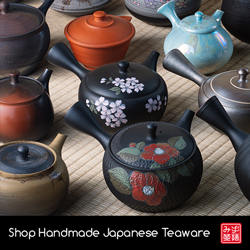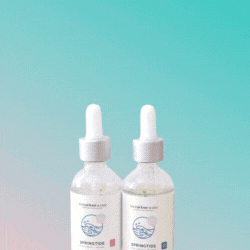
Did you know that only the tea plant (Camellia sinensis) and a few others contain L-theanine?
The characteristic flavor of green tea is due in large part to this particular compound. If you’re a green tea lover like me, you’ll definitely want to learn all about L-theanine.
What is L-theanine?
Green tea leaves contain many different amino acids. Amino acids are molecules containing an amine group(NH3), a carboxylic acid group(R-C=O-OH) and a side-chain that varies between different amino acids. They are the building blocks of proteins, although some of them don’t form any proteins.
When green tea is brewed, only the water-soluble amino acids become relevant. L-theanine makes up to 60% of that amino acid content. Its molecular formula is C7H14N2O3, it is also known as 5-N-ethyl-glutamine, and it’s a non protein-forming amino acid.
L-theanine is important because it adds to the umami flavor (tastiness) and sweetness of green tea.
What makes L-theanine so special?
 So what else does L-theanine do besides providing flavor?
So what else does L-theanine do besides providing flavor?
The main benefit of L-theanine is that it increases alpha brain wave activity, which induces relaxation. By relaxing you are effectively able to reduce stress!
On top of that, it combines with caffeine in a matter that produces relaxed alertness. L-theanine lets you enjoy the increased-concentration effect from caffeine (also found in green tea) without the associated anxiety and restlessness.
L-theanine was approved by The Japanese Ministry of Health and Welfare for universal consumption in 1964, while in the US the FDA approved its use as a dietary supplement.
L-theanine content in green tea
Gyokuro is known for having a high amount of L-theanine. Do you know why? L-theanine is slowly converted into catechins due to photosynthesis.
Because gyokuro cultivation involves shading the tea plant, less photosynthesis occurs so that more L-theanine is left on the leaves. In fact, L-theanine gives gyokuro its characteristic sweetness and balanced flavor.
Younger leaves have more L-theanine than older ones, while later harvests have each less L-theanine. Shaded teas like gyokuro, kabusecha and matcha are a good source of L-theanine. Also look for teas made from the first harvest.
There are more benefits of L-theanine, which I will be sharing with you on a later post about the health benefits of green tea. Meanwhile, relax with your favorite type of Japanese green tea with the help of L-theanine.
sources:
www.wikipedia.org
Asia Pacific Journal of Clinical Nutrition; L-theanine Reduces Psychological and Physiological Stress Responses; A.C. Nobre et al.; 2008
The combination of L-theanine and caffeine improves cognitive performance and increases subjective alertness>; Nutritional Neuroscience 13.6 (2010): 283-90






August 8, 2012
Si total la L-teanina una vez ingerida es liberada al torrente sanguineo,y se dirige al cerebro,donde estimula las ondas cerebrales … las cuales son impulsos electricos que tienen correlacion con distintos tipos de estados mentales y animicos … hay cuatro categorias de Ondas cerebrales:
Alfa : presentes especialmente durante los estados de alerta relajada .
Beta : presentes durante las situaciones ligeramente estresantes o emocionantes.
Delta : Estan presentes durante la etapa mas profunda del sueño.
Theta : Presentes especialmente durante el sueño ligero y la somnolencia .
August 9, 2012
Hello Catalina
I didn’t know about the other 3 waves.
I speak Spanish too, but since this blog is written in English, I prefer comments written in that language so that everyone can understand.
Thank you for your comment!
September 18, 2013
Nice article. However, I don’t believe L Theanine can be both a source of umami and sweetness. For one thing umami comes from glutamate (as in msg) which is a protein forming amino acid, whereas, as you pointed out, L Theanine is a non protein forming amino acid.
September 18, 2013
Hello Terry, thanks for your comment.
L-theanine is not a direct source of umami, but apparently its presence amplifies the intensity of umami flavor, originally due to the glutamate (also present in tea leaves).
Here’s a study for you to look at: http://www.aseanfood.info/Articles/11016318.pdf
It’s also mentioned on page 29 of the Nihoncha Instructor Association book: 日本茶のすべてがわかる本.
September 20, 2013
Thank you for the reference Richard. It has been very helpful. I have referred it to other tea aficionados (along with the link to your blog). I have one other question. A person recently told me that L Theanine is created in the roots and delivered to the rest of the plant via the roots and vascular system. He maintains the highest concentration is in the roots and diminishes as you go further away from the roots, with the leaves having the least L Theanine content. Have you ever heard of this?
September 20, 2013
Hi Terry, thanks for the referral : )
Yes, L-theanine is produced in the roots (see my post about gyokuro in the “Types of Japanese green tea” tab), but when it gets to the leaves it’s converted into catechins via photosynthesis, that’s why gyokuro must be shaded to preserve the L-theanine.
I’ve never heard of people consuming the roots of the tea plant for the L-theanine content, though.
October 9, 2018
Hi Ricardo,
Thank you for your interesting information.
“Younger leaves have more L-theanine than older ones, while later harvests have each less L-theanine.” – if L-theanine comes from the roots, doesnt mean that older leaves should have more of this amino acid?
October 10, 2018
Hi Vince, thanks for commenting.
Try a shincha (young leaves from first harves) and a bancha (older leaves). You can easily tell that there’s more umami flavor and sweetness in the shincha, which is due to higher amino acid content. The tea plant turns L-theanine into catechins through photosynthesis, so the older the tea leaves the less amino acids.
Also, older tea leaves have a lot of fiber, you can also tell because they are harder and tougher. Fiber makes up for a lot of mass in a leaf, but it is tasteless.
September 2, 2015
Hi,
Very interesting this article.
Thanks Ricardo.
September 2, 2015
Thank you for your comment Angie.
It’s nice to hear that you found the content interesting.
September 13, 2015
I’m so happy to have found your blog Ricardo. I’ve recently become obsessed with tea, particularly green teas. 🙂 I drink many cups of Houjicha as well as Chinese Gunpowder throughout the day while I continue to explore the many other styles available.
One thing I’ve noticed since basically giving up coffee is that tea has such a well-balanced effect…both mental alertness and also a sense of well being and relaxation. Truly a great beverage as well as medicine for those like me who suffer from anxiety and depression.
Thanks again for sharing all this helpful info on Japanese tea 🙂 I have yet to try many of the varieties and am looking forward to years of tea enjoyment.
September 13, 2015
Thank you for your kind comment Chris.
I don’t drink coffe either, and drinking tea always makes me feel relaxed.
I wish you much fun in your journey to the world of tea.
March 11, 2016
Hello everyone!
I have a question.
I am all about L-Theanine …. and I wonder … since Match has around 50mg per serving … how much does Gyokuro has per 5g of leafs?
Thanks in advance
March 11, 2016
Hi Sasha
The content of matcha and gyuokuro should be very similar, because their cultivation process is practically the same.
However, since gyokuro is a loose leaf tea, you have to make multiple infusions or basically eat the tea leaves to get the full L-theanine content, while in matcha you are ingesting it all.
July 29, 2016
I ditched coffee for matcha tea. Matcha tea, if done right, it’s deliciuos and extremely relaxing for me; I drink it before bedtime and I sleep better.
July 29, 2016
Hello Maria
Thanks for your comment. Good to hear that matcha works for you at night.
June 6, 2017
Hello Ricardo
Nice blog.
My question goes in direction if kukicha tea contains theine (teina), as everyone says is theine and caffeine free and I cannot sleep if i drink at night.
Thanks
Ana
June 6, 2017
Dear Ana
I quote from Wikipedia: “In 1827, M. Oudry isolated “théine” from tea, but it was later proved by Mulder and by Carl Jobst that theine was actually caffeine.”
There is no theine, just caffeine. But kukicha isn’t very high in it. Also, L-theanine is relaxing, so the effect is not the same.
July 16, 2019
Since kukicha has a pretty high theanine content and a low caffiene content, I was wondering if people find that the net effect is that they get more relaxed and sleepy rather than more awake. I haven’t tried kukicha yet so I am curious what other people’s experience is, or if each person experiences it differently.
I have tried a few servings of a matcha that has about 40 mg theanine and 70 mg caffeine per serving. I’ve found that it wakes me up a little, but not much. I’m wondering if, in my system, the caffeine is being mostly balanced out by the theanine.
July 18, 2019
Hi Paul
When you mix caffeine and L-theanine, you become alert but calm.
I drink kukicha somewhat often, and I feel calmed down but not sleepy.
Actually I drink many different teas throughout the day, mostly green. Even before going to sleep.
But I have no trouble sleeping, perhaps I’m already resistant to caffeine.
July 18, 2019
I had 1g matcha last night about 2 hours before bed and it didn’t seem to affect my sleep, even though I believe I am sensitive to caffeine. If anything, I’d say the matcha helped me sleep better.
In a way this is good because it means I can enjoy a matcha at night, but so far I have not experienced much of the alertness effect that other people mention. I wonder if it’s because I’m especially sensitive to L-theanine also. Even a normal brewed bancha tends to wake me up more than a 2g serving of matcha, despite having a lot less caffeine.
Perhaps I’m the only one that experiences it this way!
July 18, 2019
Hi Paul
I guess that the effects vary from person to person.
The other way to test it is by drinking decaffeinated matcha and see if you feel any difference.
July 18, 2019
Decaf matcha, I’ve never even heard of it! Where can I find that? As long as the decaffeination process does not interfere with the theanine too much then it would be an interesting test! I also think I need to get my hands on some kokicha, but my favorite tea seller is out of stock.
July 19, 2019
I reviewed this one:
https://www.myjapanesegreentea.com/domatcha-masters-low-caffeine-matcha
July 19, 2019
Dang that is pretty expensive at $40/oz! But I would like to try sometime.
I was wondering, do you have a comparative review of many brands of specific types of tea or matcha, to help us decide which brands to try or what prices we should expect for good quality? As you know high quality Japanese green tea/matcha can get very expensive so it’s helpful to narrow down the search.
July 19, 2019
I don’t write that kind of posts, mainly I prefer to let people choose because tastes are different.
Good quality matcha is always expensive, ceremonial matcha starts at $1 per gram. It’s usually the case that the more it costs, the better it is.